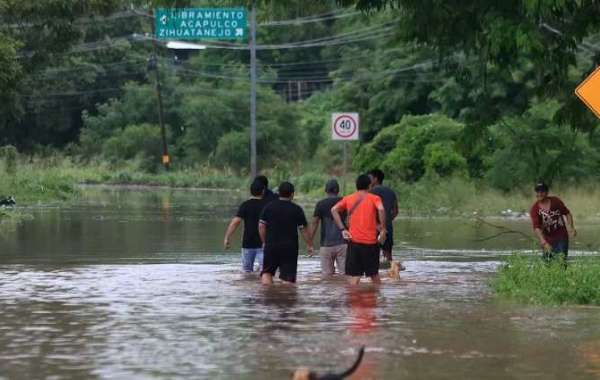An "extremely dangerous" hurricane, identified as Hurricane Lidia and classified as a Category 4 storm, has reached the shores of Mexico's Pacific coast. Prior to its arrival, the US National Hurricane Center (NHC) projected wind speeds of up to 140mph (220km/h) in the state of Jalisco.
Flash flooding is also expected.
Mexico's President Andrés Manuel López Obrador said 6,000 members of the armed forces had been deployed to help residents.
The hurricane made landfall on Tuesday evening near the resort town of Puerto Vallarta.
Local residents are taking shelter from the storm, while shopkeepers have boarded up windows and piled up sandbags in case of flooding.
Earlier, the city's airport announced it was closing from 16:00 local time (22:00 GMT) until 08:00 on Wednesday.
Mexico's President Andrés Manuel López Obrador said civil protection personnel were on alert and around 6,000 members of the armed forces had been deployed to help residents.
"I urge people living between Nayarit and Jalisco, especially in Bahia de Banderas, Puerto Vallarta and Tomatlan, to take precautions," he said on social media platform , recommending people to stay away from low-lying areas, rivers and slopes.
Forecasters at the NHC say Lidia - a Category 4 status on the Saffir-Simpson Hurricane Wind Scale which goes up to five - will bring heavy rainfall of up to 12 inches (30cm).
It will likely produce flash and urban flooding alongside possible mudslides in areas of higher terrain across the state of Nayarit, southern parts of the state of Sinaloa, and coastal areas of Jalisco state in western Mexico.
The strength of Lidia's winds, however, is expected to weaken rapidly after it moves inland.
Parts of Mexico's Pacific coastline have already seen significant flooding this week after Tropical Storm Max hit. Local media reports that two people died as a result of the storm in the state of Guerrero.
Hurricanes hit Mexico every year on both its Pacific and Atlantic coasts. The country's official hurricane season runs from May to November, with most storms developing between July and October.
The impact of climate change on the frequency of storms is still unclear, but scientists say that increased sea surface temperatures warm the air above and make more energy available to drive hurricanes, cyclones and typhoons.
As a result, they are likely to be more intense with more extreme rainfall.
The Earth has already experienced an increase of approximately 1.1 degrees Celsius (1.98 degrees Fahrenheit) since the onset of the industrial era, and temperatures will continue to climb unless governments worldwide implement substantial reductions in emissions.
The above is about The《Highly Hazardous Hurricane Lidia Strikes Mexico's Pacific Coast》, and finally, I would like to recommend you a pair of shoes cheap air jordan 1 vs 2.








